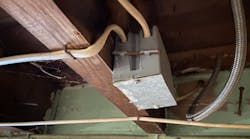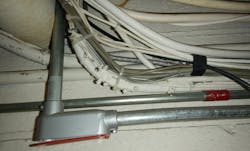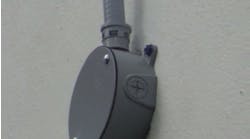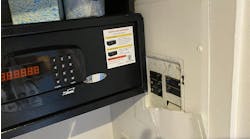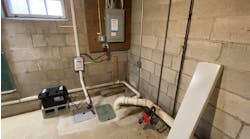All references are based on the 2023 edition of the NEC.
Unfinished Basement Business
It is quite common for me to find violations in unfinished basements of dwelling units. One of the more common violations I find is NM cables that have been secured directly to the bottom of joists or framing members as seen in this Photo. Section 334.15(C) addresses NM cables installed exposed in unfinished basements. It permits cables no smaller than two 6 AWG or three 8 AWG to be secured directly to the bottom of the joists when run at angles with the joists, perpendicular in this case. It requires smaller cables, such as the 12/2 or 14/2 in the Photo to be run through holes drilled through the joists or on running boards that could be secured to the bottom of the joists. I am also concerned about the use of that field-made metal cover installed on the PVC device box. Is it grounded and bonded? If so, then how? Several Sections in Art. 250 require the metal cover to be grounded and bonded, including Secs. 250.4(A)(5), 250.86, 250.110, and 250.134 for starters. Lastly, the sharp bend in the NM cable where it passes around the bottom of the joist may not comply with the bending requirements in Sec. 334.24.
Installers Cutting Corners
This is another example of an all-too-common violation I encounter. Using a raceway to support a bundle of cables in this manner is not permitted. There are several rules we can look at here. First, Sec. 300.11(C) permits raceways to be used as a support for cables but only under very specific conditions, of which, none apply here. Next, Sec. 358.12(2) prohibits using electrical metallic tubing (EMT) to support luminaires or other equipment except conduit bodies no larger than the trade size of the EMT. Additionally, Sec. 722.24(A) requires the installation of cables used for Class 2 and Class 3 power-limited circuits, power-limited fire alarm (PLFA) circuits, and Class 4 fault-managed power circuits to conform to Sec. 300.11. Section 722.24(B) also prohibits these cables from being secured to the exterior of any conduit or raceway as a means of support. For optical fiber cables, Sec. 770.133(D) prohibits this type of installation too. Lastly, for communication circuits, Sec. 800.133(C) prohibits communications wires and cables and CATV-type coaxial cables from being strapped, taped, or attached by any means to the exterior of any raceway as a means of support. Installers ignored all those rules here.
